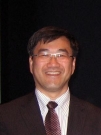
Lead by the Editor-in-Chief Prof Insup Noh, Biomaterials Research has recently reached its first anniversary of being published by BioMed Central. Furthermore, Biomaterials Research is delighted to welcome eight new members to the editorial board and here we ask three of them about the developments in their field of biomaterials research.
Ren-Ke Li, Canada

Ren-Ke is a Senior Scientist at Toronto General Research Institute, and Professor of Cardiovascular Surgery at University of Toronto. In 1996, he demonstrated for the first time that transplanted cardiomyocytes can improve heart function. And he proposed ‘rejuvenation’ as a new concept for stem cell therapy for aged patients.
What are the roles of biomaterials in rejuvenation and how can we use it to improve the stem cell therapy for aged patients?
Cells, including stem cells, live in their perfect microenvironments and function as directed by surrounding signals. Aging causes the dysfunction of cells, and most importantly is due to the alteration of the microenvironment.
One method to rejuvenate aged cells is to change their cellular microenvironment. Biomaterials and tissue engineering are perfect technologies to create microenvironments that change cellular function. We have shown that proper micro-milieu is able to enhance the cellular function of cells derived from aged patients, and thereby induce ‘rejuvenation’.
Jake Barralet, Canada

As Vice Chair of Research, Department of Surgery and Professor in the Faculties of Medicine and Dentistry at McGill University, Jake specializes in bioceramics, in particular; low temperature syntheses of nanocrystalline and amorphous inorganics, cold setting materials (cements) and precipitation to create new or improved materials or devices for tissue repair or delivery.
What’s the impact of Bioceramics on people’s lives around the world?
Of course bone fillers, scaffolds, ceramic crowns, ceramic prosthesis bearings and plasma sprayed coatings flash through most people’s mind. They have indeed all had tremendous impact on improving quality of life and arguably in essentially creating the biomaterials field of material-tissue interactions.
I think it is fair to say though that the original industrial scale uses of calcium phosphates in protein purification e.g. in antibody manufacture, fertilizers, rendering toxic soil contaminants relatively insoluble and even tableting excipients probably touch the lives of more people globally.
It is from and to these applications where we can apply our interdisciplinary skills to bear on improving existing materials and developing new ones. The use of titanium in orthopaedic and oral surgery is ubiquitous but isn’t it titanium oxide that gives it its bone bonding ability?
Not only the intentional use of bioceramics, but their prevalent pathological formation sadly touches many of our lives and there is huge need for us to help control this unwanted biomineralisation.
Bioceramics researchers are expert at creating new properties from a limited list of ‘ingredients’, mainly phosphates, carbonates, sulphates, silicates and oxides using non-toxic and often low temperature processing routes to comply with regulatory legislation.
These skills are increasingly in demand by industry needing to produce inorganics while complying with new environmental legislation and minimizing high energy consumption. The beneficial impact of bioceramics research then can only affect more people globally in the future and only just recently Korean labs turned phosphorus into a 2D conductor.
One thing is for sure; there will be many new applications and opportunities as bioceramics materials chemistry continues to evolve.

Dan Peer, Israel
Dan is Professor of the Laboratory of Nanomedicine at Tel Aviv University in Israel. He and colleagues have successfully developed the ‘cancer bullet’ system, which is a nanoparticles-based treatment to target cancer cells.
How effective is nanomedicine in treating cancer?
This is a tricky question. There have been a lot of activities with numerous strategies being developed (currently more than 250 clinical trials at different stages with different strategies) and more than 30 nanomedicines already in clinical practice. These range back from 1995 with the first FDA approved liposomal Doxorubicin (DOXIL) to today.
Still, there are numerous challenges that need to be overcome in order to show superior efficacy and improve toxicity profile compared with free drugs. This is true for solid tumors which represent more than 80% of cancers but also for blood cancers (a group of 57 diseases including lymphoma, leukemia and myeloma).
Thus, still basic research and translational work is essential in order to better understand biological and pathological barriers, tumor heterogeneity and the abilities of different strategies to really make an impact on cancer patients’ lives by improving the efficacies of treatments and decreasing the drug toxicity without introducing new types of toxicities.
What are the roles of biomaterials in nano-level?
Generating new biomaterials could really make the different between a toxic formulation and a successful one or between an ineffective treatment and a superior treatment. Therefore, at the nano-level, biomaterials can open new avenues for therapeutic and diagnostic strategies and can impact fields such as cancer diagnostics and therapeutics (even theranostics) as well as inflammatory disorders including neurodegenerative diseases, inflammatory bowel diseases, sepsis and many autoimmune diseases.
We would also like to welcome the following new board members: Peter Dubruel (Belgium), Feng-Huei Lin (Taiwan), Joana Magalhães (Spain), Abhay S Pandit (Ireland) and Murugan Ramalingam (India).
Karen Cheng
Latest posts by Karen Cheng (see all)
- Hepatitis research and therapy around the globe – Q+A with editors and reviewers - 28th July 2016
- A new era for Inflammation and Regeneration: an Editor Q+A - 25th April 2016
- Little Fish, Big Role - 19th November 2015
Comments